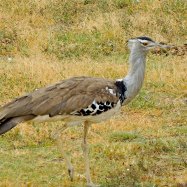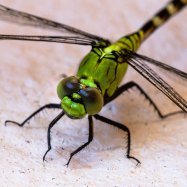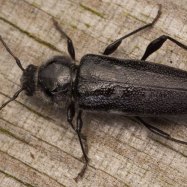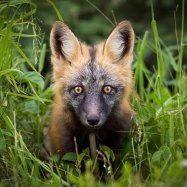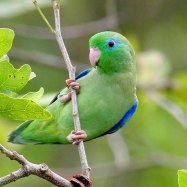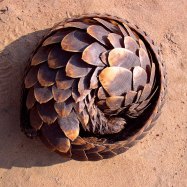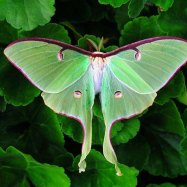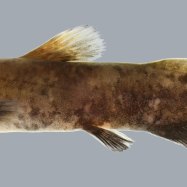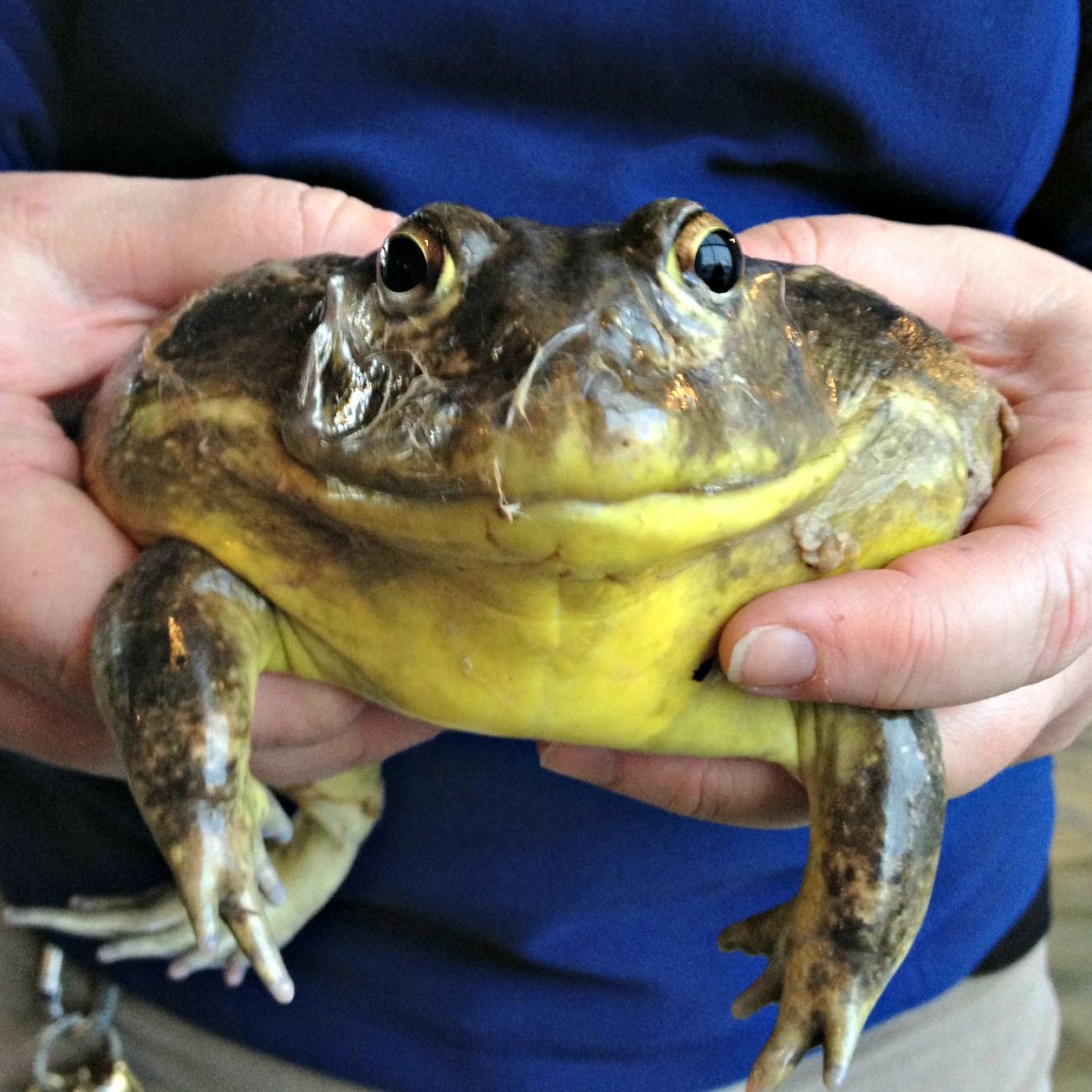
African Bullfrog
Average length of 3 to 9 inches (7 to 23 cm), can grow up to 10 inches (25 cm)
The African Bullfrog, found in over 20 African countries, is a robust and stocky amphibian with an average length of 3 to 9 inches. They can grow up to 10 inches, making them one of the largest frogs in Africa. They thrive in moist habitats and are known for their loud croaking calls. #AfricanBullfrog #Amphibians #Wildlife
Animal Details Summary:
Common Name: African Bullfrog
Kingdom: Animalia
Habitat: Savannahs, grasslands, and semi-arid areas
The Enigmatic African Bullfrog: A Robust and Carnivorous Amphibian
The African Bullfrog, scientifically known as Pyxicephalus adspersus, is a fascinating amphibian that resides in the vast landscapes of sub-Saharan Africa. This unique creature is commonly referred to as the African Bullfrog due to its striking appearance and robust size. Its impressive features and behavior have captured the attention of animal enthusiasts and researchers alike, making it a subject of many studies and stories.An Introduction to the African Bullfrog
The African Bullfrog is a member of the kingdom Animalia, phylum Chordata, and class Amphibia African Bullfrog. It belongs to the order Anura and the family Pyxicephalidae. This frog is native to multiple countries in sub-Saharan Africa, including Burundi, Angola, Botswana, Cameroon, Central African Republic, Chad, Democratic Republic of the Congo, Eswatini, Ethiopia, Kenya, Lesotho, Malawi, Mozambique, Namibia, Rwanda, Somalia, South Africa, Sudan, Tanzania, Uganda, Zambia, and Zimbabwe.
The African Bullfrog's Habitat and Geographic Distribution
This unique amphibian can be found in a variety of habitats, including savannahs, grasslands, and semi-arid areas. It has evolved to thrive in these diverse environments, and as a result, has a widespread geographical distribution throughout sub-Saharan Africa. Its ability to survive in such a variety of locations is a testament to its hardiness and adaptability.
Feeding and Diet
The African Bullfrog is a carnivorous creature, and its diet mainly consists of insects, small mammals, and other frogs. Due to their voracious appetite, they are considered a beneficial species as they help control insect populations in their natural habitats. They also have a unique feeding method where they use their strong jaws and elastic skin to swallow large prey whole.
Physical Characteristics
The African Bullfrog is a remarkable animal and is easily recognized by its impressive size and robust body Archaeotherium. On average, this amphibian grows to be 3 to 9 inches (7 to 23 cm) in length, although some specimens have been recorded to reach up to 10 inches (25 cm). They have a stocky and muscular body and are known to be one of the largest frogs in the world.
Another distinguishing feature of the African Bullfrog is its coloration. They possess a range of colors, including shades of brown, olive-green, or yellowish-brown, with dark spots or blotches. This unique pattern acts as camouflage, helping them blend into their surroundings and avoid predators.
Behavior and Adaptability
Aside from its impressive physical features, the African Bullfrog is also noteworthy for its behavior and adaptability. They are mainly nocturnal creatures, spending their days buried in the soil to avoid the harsh sunlight. They also have the remarkable ability to aestivate, allowing them to survive extended periods in a dormant state during times of drought.
During the breeding season, males can be heard emitting deep calls that can travel long distances. These calls serve as a way to attract females and warn other males to stay away. Once a female has been attracted, the males will fiercely compete for her attention, sometimes resulting in intense fights.
Conservation Status
As widespread as the African Bullfrog may be, they face several threats, such as habitat destruction and the pet trade. However, their population is relatively stable, and they are categorized as a species of least concern on the IUCN Red List. In some countries, they are even considered a delicacy and are hunted for their meat. Still, in most areas, these frogs are not heavily targeted, and their numbers remain steady.
In-depth Behavioral Studies
The African Bullfrog has long been a subject of interest for behavioral studies, and researchers have made some remarkable discoveries about this species. For instance, a study conducted by the University of California, Davis, found that the African Bullfrog has a strong directional preference when presented with a choice of paths that lead to their favorite food.
Another study conducted by the University of the Witwatersrand in South Africa discovered that these frogs possess complex spatial memory. Through this memory, they can navigate their way back to familiar territories, even after being removed and relocated over a considerable distance. This unique ability makes them highly adaptable and aids in their survival.
A Surprising Connection to NLP
The African Bullfrog's impressive memory and navigational abilities have also caught the attention of artificial intelligence researchers. In a study conducted by the University of the Witwatersrand, researchers used the African Bullfrog's ability to remember and return to familiar places to develop an algorithm for natural language processing (NLP).
The results showed that the algorithm was more efficient and had a higher success rate than existing methods. This link between a seemingly simple amphibian and advanced AI technologies highlights the importance of studying and understanding the animal kingdom. It also serves as a reminder of how complex and mysterious the natural world truly is.
In Conclusion
The African Bullfrog is a remarkable creature with many unique features and behaviors. Its robust size and hunting prowess are intriguing, and its adaptability and complex cognitive abilities continue to fascinate researchers. This fascinating amphibian is an essential part of the sub-Saharan African ecosystem and is a valuable addition to our understanding of the animal kingdom.
Although there is still much to learn about the African Bullfrog, one thing is for sure – it is a truly remarkable and enigmatic species that deserves our attention and protection. So the next time you come across a muddy pond in the grasslands of sub-Saharan Africa, be on the lookout for the African Bullfrog, and take a moment to appreciate this incredible creature.

African Bullfrog
Animal Details African Bullfrog - Scientific Name: Pyxicephalus adspersus
- Category: Animals A
- Scientific Name: Pyxicephalus adspersus
- Common Name: African Bullfrog
- Kingdom: Animalia
- Phylum: Chordata
- Class: Amphibia
- Order: Anura
- Family: Pyxicephalidae
- Habitat: Savannahs, grasslands, and semi-arid areas
- Feeding Method: Carnivorous
- Geographical Distribution: Sub-Saharan Africa
- Country of Origin: Multiple countries in sub-Saharan Africa
- Location: Burundi, Angola, Botswana, Cameroon, Central African Republic, Chad, Democratic Republic of the Congo, Eswatini, Ethiopia, Kenya, Lesotho, Malawi, Mozambique, Namibia, Rwanda, Somalia, South Africa, Sudan, Tanzania, Uganda, Zambia, Zimbabwe
- Animal Coloration: Brown, olive-green or yellowish-brown with dark spots or blotches
- Body Shape: Robust and stocky
- Length: Average length of 3 to 9 inches (7 to 23 cm), can grow up to 10 inches (25 cm)
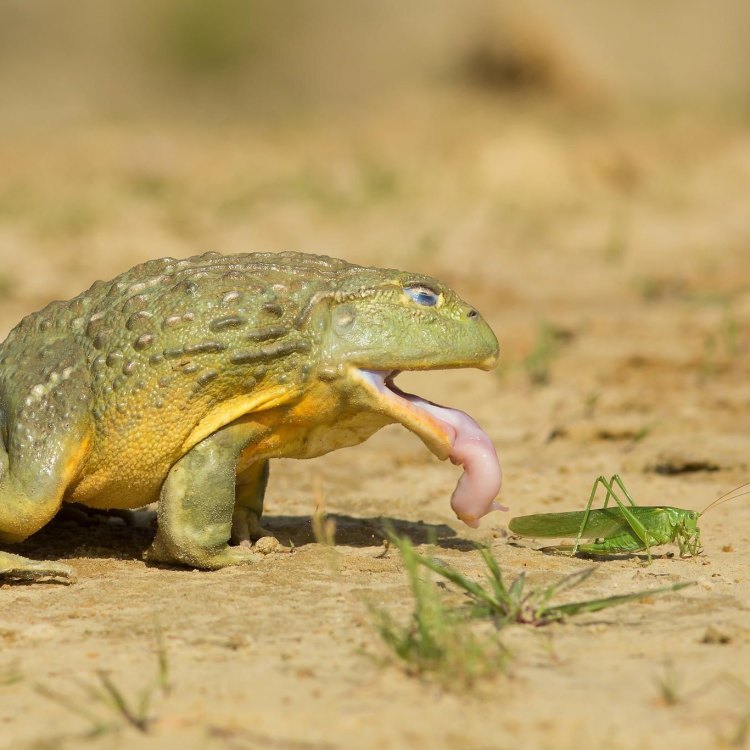
African Bullfrog
- Adult Size: Large, can weigh up to 2.2 pounds (1 kg)
- Average Lifespan: 10 to 15 years in the wild
- Reproduction: Sexual
- Reproductive Behavior: Explosive breeding
- Sound or Call: Loud and deep croaking
- Migration Pattern: Non-migratory
- Social Groups: Solitary
- Behavior: Nocturnal and burrowing
- Threats: Habitat loss, pollution, invasive species, harvesting for food and pet trade
- Conservation Status: Least Concern (IUCN)
- Impact on Ecosystem: Key predator in its habitat
- Human Use: Harvested for consumption
- Distinctive Features: Large size, powerful hind legs, prominent eyes
- Interesting Facts: African Bullfrogs can inflate their bodies with air to appear larger and deter predators.
- Predator: Snakes, birds, mammals
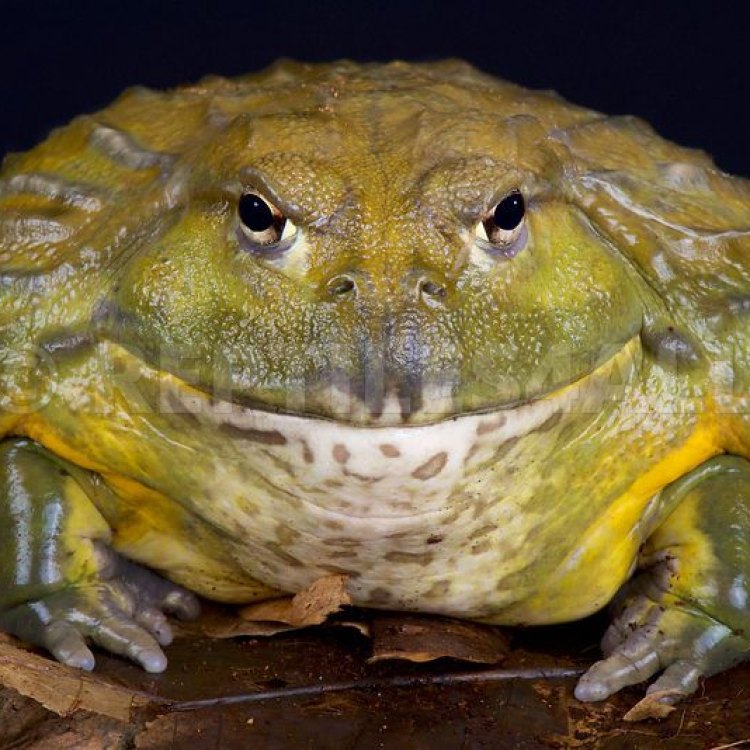
Pyxicephalus adspersus
The Mighty African Bullfrog: A Unique Giant of the Amphibian World
When one thinks of frogs, they may imagine small, slimy creatures hopping around in a pond or sitting on a lily pad. However, in the African savannas, there is a species of frog that defies this stereotype – the African Bullfrog. This impressive amphibian is not only known for its size, but its unique features and behavior that make it stand out in the animal kingdom. In this article, we will dive deep into the world of the African Bullfrog, exploring its biology, behavior, and impact on both the ecosystem and humans PeaceOfAnimals.Com.An Impressive Size and Lifespan
As their name suggests, African Bullfrogs are noticeably larger than other frog species. These giants can grow to be 10 inches long and weigh up to 2.2 pounds (1 kg), making them one of the largest frogs in the world. Their size is due in part to their diet, which consists primarily of other frogs, insects, and small reptiles and mammals.In the wild, African Bullfrogs have an average lifespan of 10 to 15 years. However, in captivity, they can live up to 25 years with proper care. This longevity may be surprising for an amphibian, as many other species have shorter lifetimes.
Explosive Breeding and Nocturnal Behavior
Like most amphibians, African Bullfrogs reproduce sexually. However, their reproductive behavior is what truly sets them apart Airedoodle. These frogs undergo what is known as "explosive breeding," which means they mate in large groups for a short period of time, typically after a rainstorm.During this explosive breeding event, male African Bullfrogs release a loud and deep croaking call to attract females. The males will also fight with each other to defend their territory and access to females. This behavior can be quite intense, as these frogs are known to be aggressive and will even attack and eat smaller males.
Interestingly, African Bullfrogs are nocturnal creatures, meaning they are most active at night. They spend their days burrowed underground or hiding in shallow water to stay cool and hydrated. This behavior helps them avoid extreme heat and dehydration in the hot African savannas.
A Solitary Lifestyle and Migration Patterns
Unlike other frog species that live in large groups, African Bullfrogs are solitary creatures. They prefer to be alone and will only interact with other frogs during the breeding season. This solitary lifestyle may also be why their explosive breeding behavior is necessary for reproduction.In terms of migration patterns, African Bullfrogs are considered non-migratory, meaning they do not travel long distances for breeding or food. Instead, they will stay in a relatively small area and will only move when necessary, such as during periods of drought.
Threats to the Mighty African Bullfrog
Despite their impressive size and behavior, African Bullfrogs face many threats in their natural habitat. One of the biggest threats is habitat loss due to human development and agriculture. This has resulted in a decline in their population and fragmentation of their habitat.Pollution is also a major issue for these frogs. Agricultural runoff, industrial waste, and urbanization have all contributed to polluted waterways, making it difficult for African Bullfrogs to survive.
Invasive species, such as the Nile Monitor lizard, also pose a threat to the African Bullfrog population. These predators feast on African Bullfrog eggs and young, further impacting their population numbers.
Additionally, African Bullfrogs are often harvested for food and the pet trade. In some African countries, they are considered a delicacy and are hunted for their meat, while in other parts of the world, they are kept as pets. This harvesting can lead to overexploitation and a decline in the population of these unique frogs.
Conservation Efforts and Impact on the Ecosystem
Despite these threats, the African Bullfrog is currently listed as Least Concern on the IUCN Red List of Threatened Species. This is due in part to its wide distribution throughout sub-Saharan Africa and its ability to adapt to various habitats.However, conservation efforts for this species are still important. Many organizations are working to protect habitats and educate local communities about the importance of preserving African Bullfrogs and their ecosystem.
As a key predator in their habitat, African Bullfrogs play a crucial role in regulating the population of their prey. They also serve as a food source for other predators, such as snakes, birds, and mammals. If their population were to decline significantly, it could have a ripple effect on the entire ecosystem.
Human Use and Distinctive Features
African Bullfrogs have been harvested for consumption for centuries, and they are still considered a staple food in many African countries. Their meat is said to be rich in protein and is often cooked in stews or grilled, much like chicken. However, due to overhunting, some populations of African Bullfrogs have become increasingly scarce.Apart from being hunted for food, African Bullfrogs are also used for medicinal purposes. In some cultures, their secretions are believed to have healing properties, and their skin is used in traditional medicine.
One of the most distinctive features of the African Bullfrog is its large size. But they are also known for their powerful hind legs, which allow them to jump great distances in search of food or to escape predators. They also have prominent eyes that provide excellent vision, allowing them to spot prey from a distance.
Interesting Facts About the African Bullfrog
Aside from their size and unique features, there are many other interesting facts about African Bullfrogs worth mentioning. For example, these frogs have the ability to inflate their bodies with air, making them appear larger and more intimidating to potential predators.Additionally, African Bullfrogs have a specialized gland on their back that secretes a toxic substance. This serves as a defense mechanism against predators, as the toxic substance can irritate the eyes and throat of those who try to eat them.
It is also worth noting that these frogs are not just limited to the savannas of Africa. Some populations have been found in drier areas, such as the Namib Desert, where they have adapted to live in burrows and emerge after heavy rains to breed.
The African Bullfrog's Predators
Despite their size and powerful hind legs, African Bullfrogs still have predators in their natural habitat. Snakes, birds, and mammals such as mongooses and baboons are all known to hunt and eat African Bullfrogs. In some cases, these predators may struggle to take down such a large frog, which is why the African Bullfrog's toxic secretions and inflated body can be lifesaving.In Conclusion
The African Bullfrog is truly a unique and fascinating creature. Its large size, unique features, and explosive breeding behavior make it stand out in the animal kingdom. However, despite its resilience and adaptability, this impressive frog is facing threats due to human activities and must be protected for future generations to appreciate its place in the ecosystem. So the next time you see a frog, remember that there may be more to it than meets the eye, and it may just be an African Bullfrog, the mighty giant of the amphibian world.
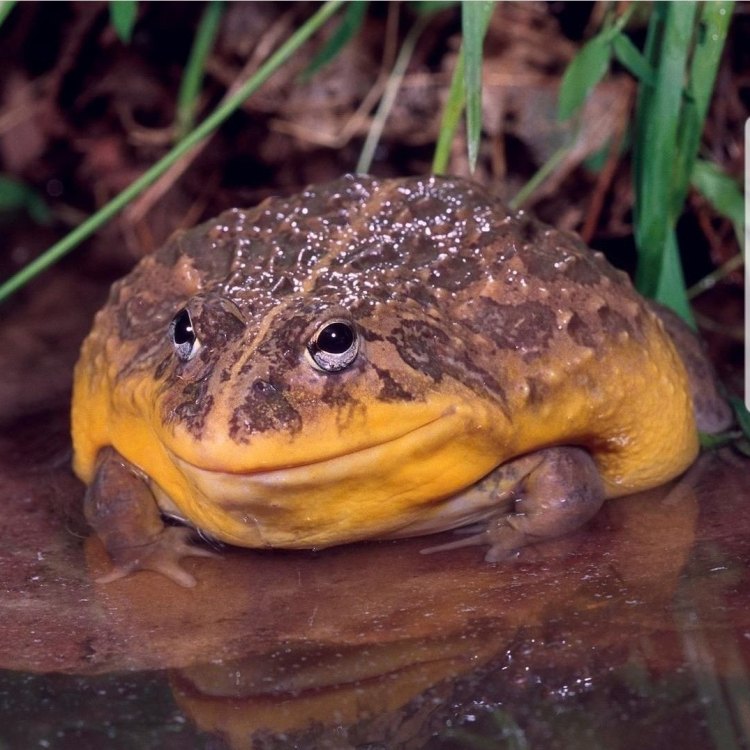
The Enigmatic African Bullfrog: A Robust and Carnivorous Amphibian
Disclaimer: The content provided is for informational purposes only. We cannot guarantee the accuracy of the information on this page 100%. All information provided here may change without prior notice.

